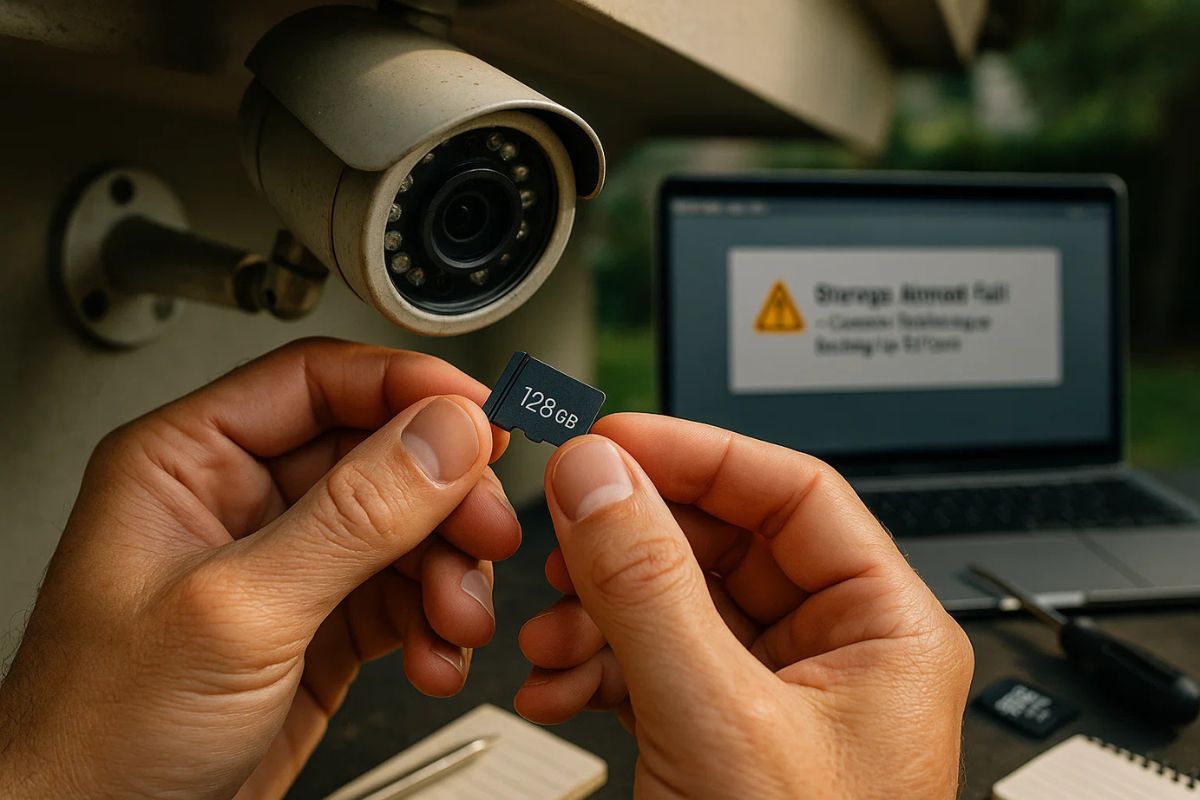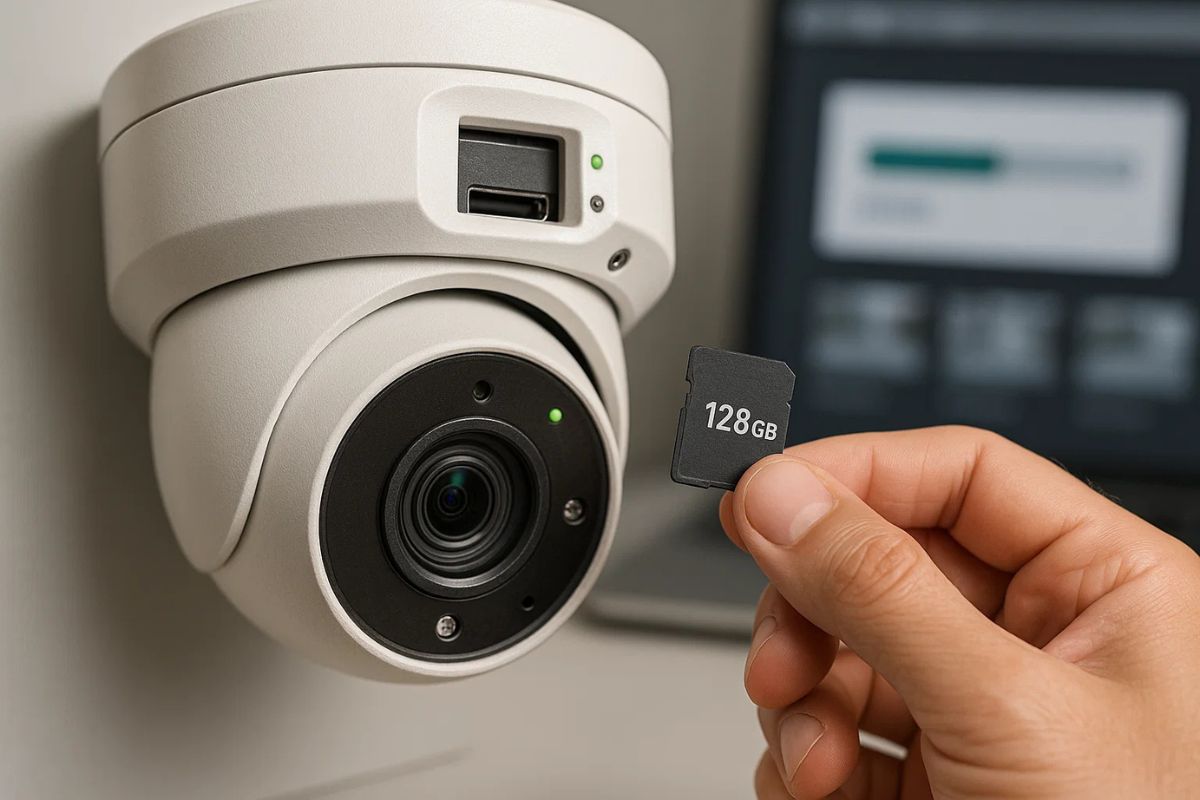Difference Between Analog and Digital CCTV Camera
CCTV cameras are a vital part of modern surveillance systems, helping monitor properties, deter crime, and ensure safety across residential, commercial, and industrial settings. When choosing a surveillance setup, one of the first decisions you’ll face is selecting between analog and digital (IP) CCTV cameras. Each type operates differently and offers unique advantages depending on your needs, and gaining clarity on their technology, performance, and cost can guide you toward the right choice for your property. To dive deeper into how these systems work and are installed, you can understand the process of CCTV and camera installation through our detailed guide for smarter decision-making.
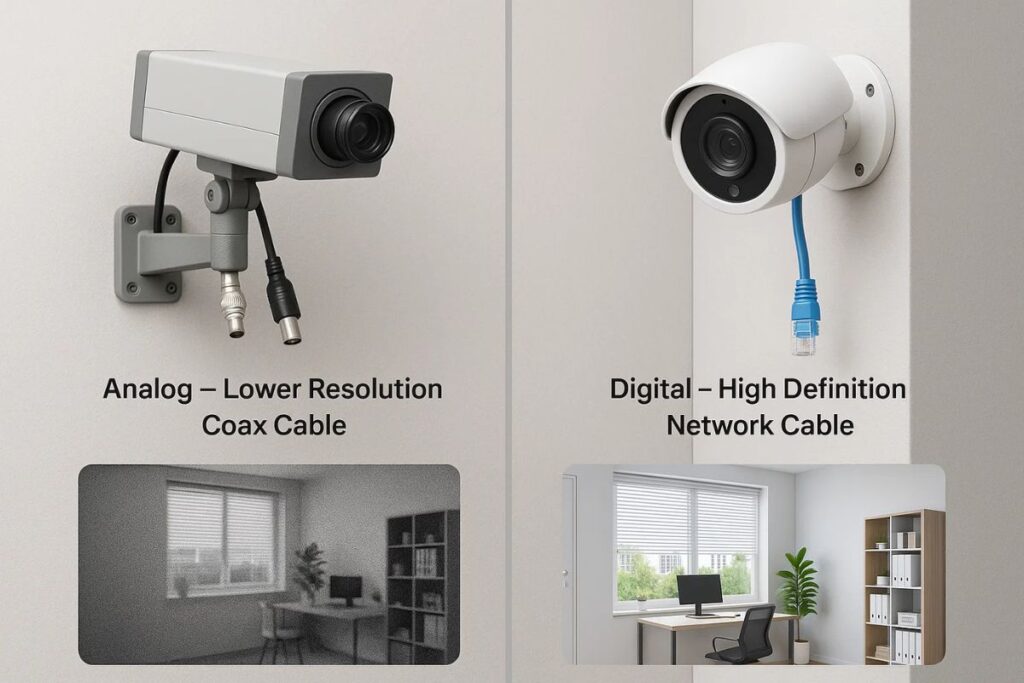
What Are Analog and Digital CCTV Cameras?
At the core of any surveillance system is the CCTV camera—its role is to capture live events and deliver visual information for monitoring, recording, or evidence collection. However, the way video is captured, processed, and transmitted varies significantly between analog and digital (IP) CCTV technologies. Analog CCTV cameras work on traditional television broadcasting principles, converting visual information into analog signals that travel through coaxial cables to a DVR, where the footage is digitized, compressed, and stored. While reliable, analog systems are limited in processing power and integration flexibility. Digital or IP cameras, on the other hand, encode and process video at the source, transmitting data over networks using Ethernet, Wi-Fi, or fiber, and sending footage directly to an NVR or cloud storage without needing a DVR. They also support decentralized setups, giving each camera its own IP address for remote access, easier configuration, and scalable system expansion. For added protection alongside your CCTV setup, you can discover how nearby technicians provide fast alarm installation to strengthen your overall security system.
Image Quality and Resolution
One of the most noticeable differences between analog and digital CCTV cameras lies in the clarity and detail of the video they produce. While both systems aim to capture visual data, the quality of that footage directly affects its usefulness in real-world surveillance situations.
Analog CCTV cameras are generally limited by older video technology, producing recordings that may appear grainy or pixelated when viewed on modern high-definition monitors. This becomes especially evident when trying to identify fine details, such as facial expressions, clothing patterns, or small objects.
Even at their best—typically capped at 1080p—analog cameras often struggle with image sharpness when objects are in motion or at a distance. As a result, they are better suited for environments where general activity monitoring is the goal, rather than precise identification.
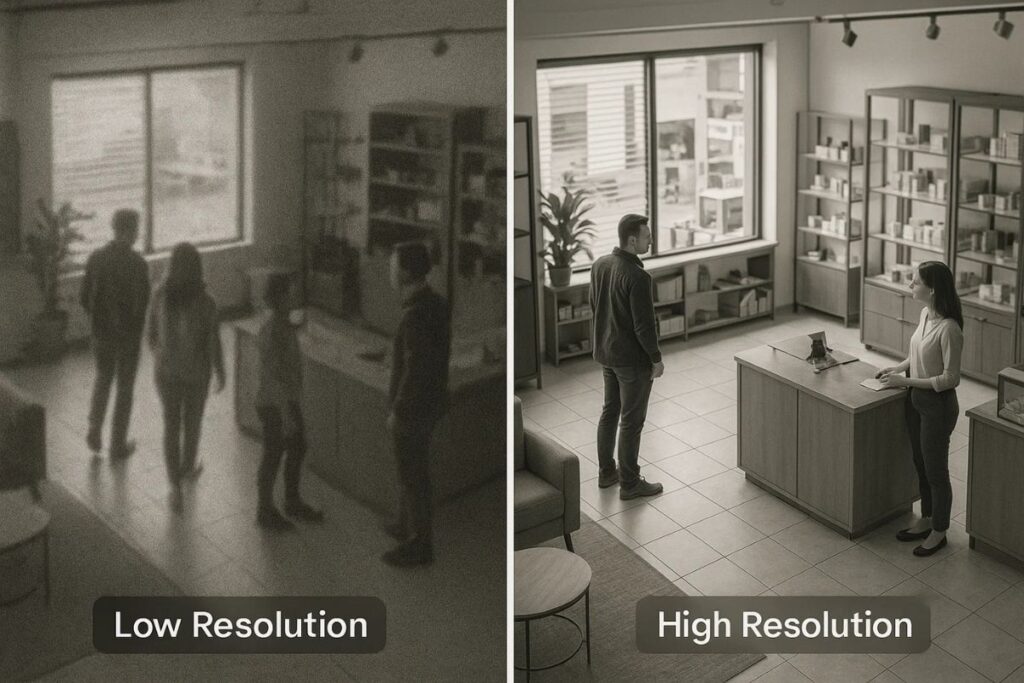
Digital or IP cameras, by contrast, use advanced image sensors and digital signal processing to deliver exceptionally sharp and vibrant footage. Models with 4MP, 5MP, or even 8MP (4K) resolution can capture intricate details clearly, even in wide-angle scenes.
This makes them particularly valuable in areas where image accuracy is crucial, such as entrances, reception desks, or locations with high foot traffic.
Another important distinction is that digital systems allow for efficient digital zoom without significant loss of clarity. In an analog system, zooming into footage typically leads to pixelation and a rapid drop in visibility. With high-resolution digital cameras, users can zoom in post-recording to examine key details such as a person’s face or a car number plate while retaining sharpness.
Additionally, many IP cameras include advanced image enhancement technologies like HDR (High Dynamic Range), digital noise reduction, and improved color balancing.
These tools help maintain clarity in challenging conditions—such as mixed lighting or indoor-outdoor transitions—where analog systems might produce overexposed or washed-out visuals. You can get reliable surveillance camera setup for your property to ensure clear, high-quality footage in any environment.
Video Transmission Method
The method by which CCTV cameras transmit video signals plays a significant role in the system’s reliability, setup flexibility, and overall performance.
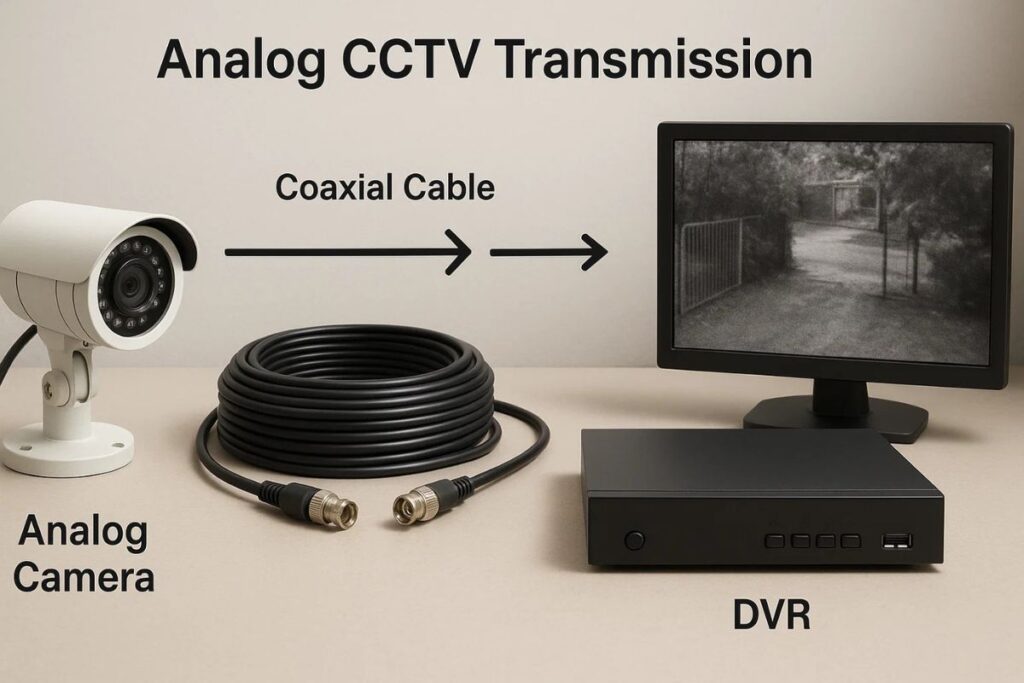
How Analog Transmission Works
Analog CCTV cameras send video signals as continuous waveforms over coaxial cables to a connected DVR.This method, while straightforward, has limitations in terms of signal integrity especially when cables run long distances or pass through electrically noisy environments.
Because analog signals degrade over length, installers must use signal boosters or high-quality cabling to maintain video clarity beyond certain distances (typically 300–500 meters).
Additionally, analog setups require a separate power supply, often through a second cable or independent power source. This not only increases the complexity of installation but also creates more potential points of failure in case of power or connection issues.
Digital Signal Transmission via IP
In contrast, digital or IP cameras encode video data into packets and transmit it over computer networks using Ethernet cables or wireless protocols.
The most common wired setup uses Power over Ethernet (PoE), which allows a single cable to handle both data transmission and electrical power.
This significantly reduces cabling requirements and simplifies the installation process especially in buildings already equipped with structured networking infrastructure.
Digital transmission is inherently more stable over long distances due to its resistance to signal interference and the use of network switches and routers to boost data flow. It also supports higher bandwidth, allowing for smoother streaming of high resolution video feeds with minimal latency.
Benefits of Network-Based Communication
Because IP-based cameras operate within the network layer, they can be remotely configured, diagnosed, or updated, unlike analog cameras which require physical access to the DVR or hardware interfaces.
This network flexibility also enables cameras to be relocated more easily without rewiring the entire system.
Moreover, digital transmission supports multiple data channels, meaning video, audio, and even control signals (for PTZ cameras) can be sent simultaneously over a single connection—further improving efficiency and expanding functional capabilities.
Storage and Video Access
The way CCTV systems store and manage footage plays a critical role in how flexible, scalable, and accessible your security solution is especially when monitoring multiple locations or requiring long-term video archiving.
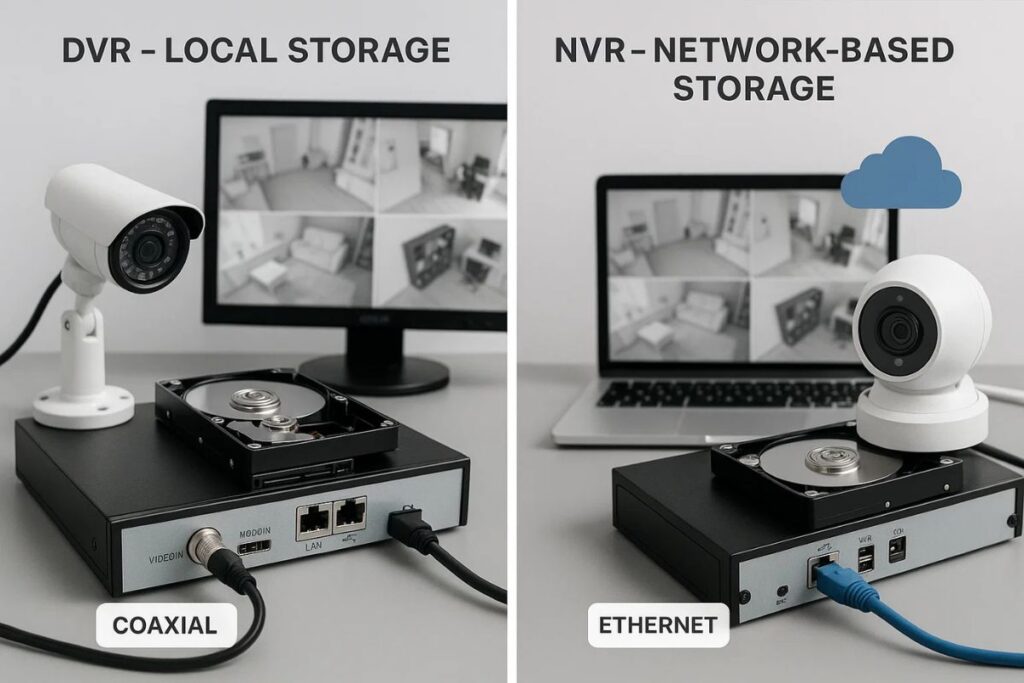
DVR vs. NVR Storage Architecture
Analog CCTV systems utilize Digital Video Recorders (DVRs) that process and store footage from each connected camera through direct coaxial wiring, requiring users to be physically near the recorder to access or review video, which limits flexibility for those needing remote monitoring. In contrast, digital/IP cameras connect to Network Video Recorders (NVRs) or cloud platforms over a network, allowing high-resolution digital streams, multi-user access, and AI-supported indexing for faster event retrieval. For homeowners or businesses looking to enhance modern surveillance capabilities, you can also hire Video Intercom System Installation in Melbourne to integrate smarter communication and monitoring into your security setup.
Accessibility and Control
One of the most significant advantages of digital CCTV systems is their ability to integrate with apps and remote access tools. Users can securely log in from any location to review footage, receive alerts, and manage settings, providing real-time control over security operations.
For businesses managing multiple premises or homeowners frequently away from home, this level of access ensures constant visibility without needing to visit the recorder physically. Moreover, cloud-based solutions often include automated backup, intelligent search, and video analytics, making incident tracking faster and more efficient.
Installation and Expansion
Analog systems usually require more wiring, making installation labor-intensive, especially for multi-camera setups. Expanding such systems involves adding more coaxial lines and power sources.
Digital CCTV systems are easier to install and scale, especially those using wireless or PoE technology. Adding a new camera may be as simple as connecting it to the network, making these systems a better fit for growing businesses or future-ready homes.
For larger properties or multi-floor offices, IP systems are far more manageable and flexible.
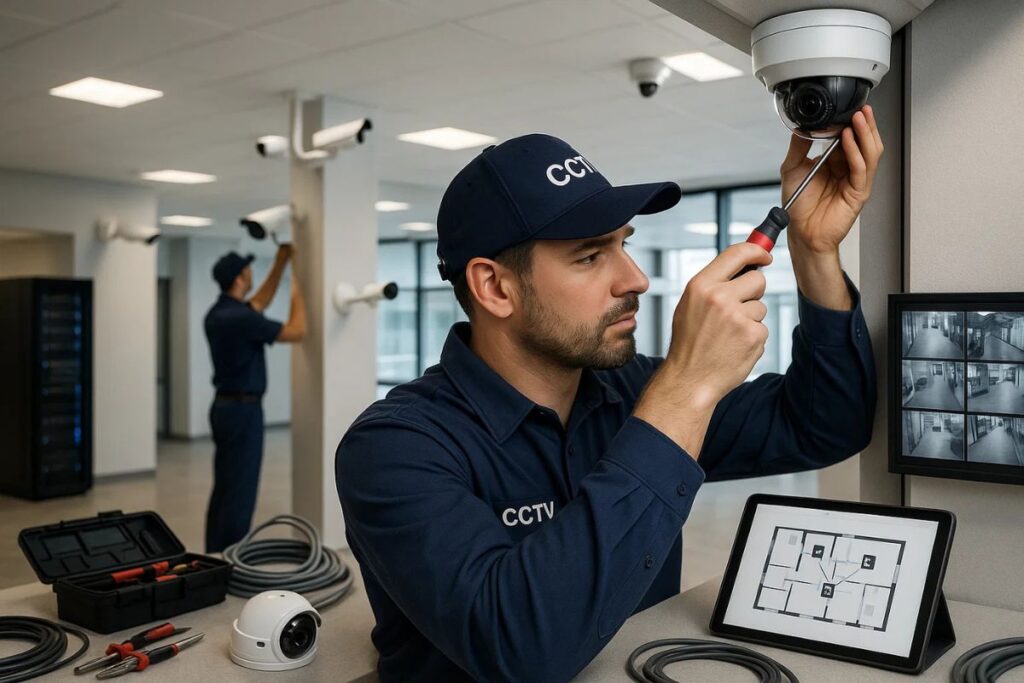
Cost Differences
Analog CCTV cameras are more affordable upfront, which makes them attractive for users on a tight budget. The cameras and DVRs tend to cost less, and there’s less dependence on advanced software or internet bandwidth.
However, IP cameras, while initially more expensive, deliver better long-term value. Their higher performance, advanced features, and ease of remote monitoring can reduce future upgrade costs.
Hidden costs such as DVR storage expansion, additional cabling, or maintenance can make analog systems more expensive over time. Similarly, IP cameras may involve costs for cloud subscriptions or NVR software licenses, depending on the provider.
Features and Flexibility
As surveillance technology evolves, the expectations from CCTV systems go beyond simply recording footage. Today, flexibility and built-in features are essential in determining how effective and user-friendly a system really is.
Core Capabilities and System Intelligence
Analog CCTV systems generally stick to the basics: continuous recording and live feed access. While this simplicity makes them easy to operate, it also means they lack adaptability. There’s no built-in intelligence to filter events, customize responses, or interact with users dynamically.
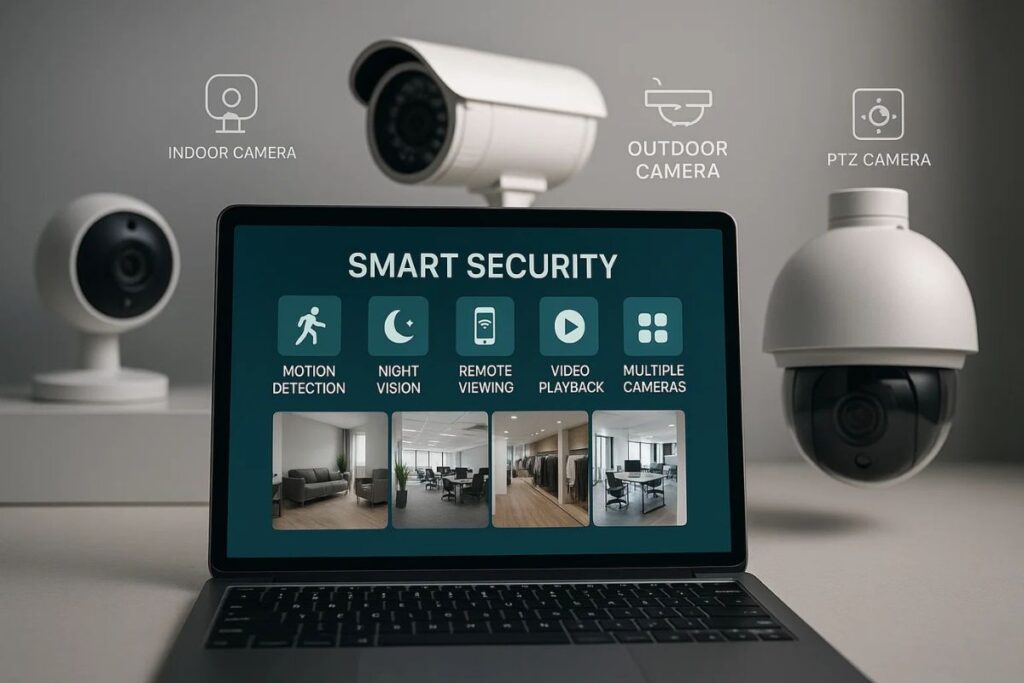
Digital (IP) cameras, in contrast, come equipped with smart event handling. They can be configured to react to specific triggers such as unusual movement, unauthorized entry, or prolonged presence in restricted zones. This means your system doesn’t just record it reacts, making surveillance more proactive than passive.
Customization and Integration Potential
Another major benefit of digital systems is their customization potential. Users can create zones of interest, schedule different recording modes, and assign unique behaviors for different cameras. These features allow the system to be fine-tuned to the specific requirements of a home, office, or facility something analog systems are not capable of.
Moreover, many IP systems integrate smoothly with broader security ecosystems or smart building platforms, opening the door to centralized control. For example, a motion alert from a digital camera can trigger smart lighting, send a push notification, and start recording simultaneously.
Future-Proofing Your Surveillance
The flexibility of digital CCTV systems isn’t just about current features it’s about being ready for tomorrow’s needs. Firmware updates can add new functionalities, software platforms frequently improve analytics, and cloud dashboards evolve to offer more insights.
Analog systems are essentially static; once installed, their capabilities rarely change unless the entire unit is upgraded. IP systems, on the other hand, grow with your infrastructure and can adapt as your security requirements evolve making them far more future-proof.
Security and Data Protection
One major drawback of analog CCTV systems is their limited security. Since video feeds are unencrypted, they’re more vulnerable to physical tampering or cable interference.
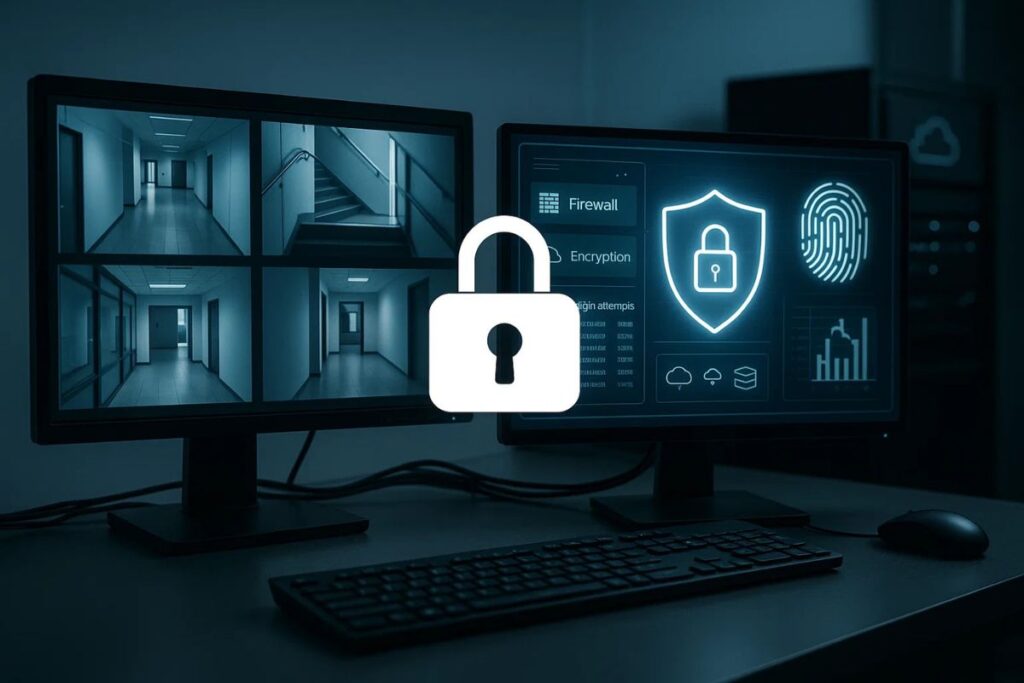
IP cameras, on the other hand, offer advanced encryption protocols to secure data during transmission. When combined with secure cloud storage and user authentication, IP systems offer a higher level of cybersecurity, protecting your footage from both physical and digital threats. For complete protection and reliable setup, you can also hire Security Alarm System Installation in Melbourne to ensure your system is properly secured and configured.



